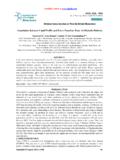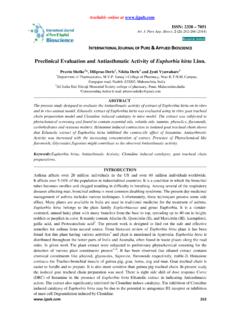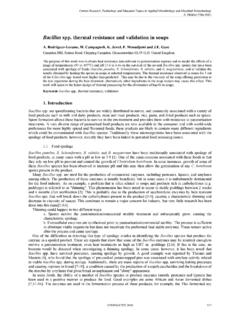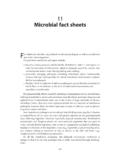Transcription of Bacillus thuringiensis Parasporins Functions on …
1 Copyright August, 2014; IJPAB 67 Bacillus thuringiensis Parasporins Functions on cancer Cells Ali Aldeewan1, 2, Yilei Zhang1, and Li Su1* 1 Key Laboratory of Molecular Biophysics of Ministry of Education, School of Life Science and Technology, Huazhong University of Science and Technology, Wuhan, China; 2 College of Veterinary Medicine, Al Basrah University, Basrah, Iraq *Corresponding Author E-mail: ABSTRACT Bacillus thuringiensis (Bt), a spore-forming gram-positive bacterium that can produce parasporal crystalline inclusions during its sporulation phase, has been widely used for agricultural insect pests control.
2 Cry has unique toxic activities against certain insects, some invertebrates, protozoa, and human cancer cells. Parasporins (PS) have been identified as Cry bacterial proteins and have been divided into six types including PS1, PS2, PS3, PS4, PS5, and PS6. PSs have been found to distinguish and kill certain cancer cells through different mechanism. PS1 was found to induce various cancer cells death by activating their apoptotic signaling and increasing Ca2+level; PS2 acted on certain cancer cells as a cytolysin by targeting on plasma membrane; PS3 and PS6 acted as a pore-forming toxin and lysis cancer cell plasma membrane; PS4 induced cancer cell death in non-apoptotic way.
3 It has been believed that the variant mechanisms of PSs acting on cancer cells indicated that different PSs may have targeted on different molecules and activated different signal pathway in cancer cells. PSs could be a series of natural bacteria products with potential roles in cancer therapy. Key words: Bacillus , Bacillus thuringiensis , Parasporins ,Cry protein, Cyt protein, cancer cell. INTRODUCTION The genus Bacillus are rod-shaped, catalase-positive and aerobic or facultative anaerobic1,which are composed of many saprophytic bacteria and able to produce endospore 2.
4 Based on spore shape and swelling properties of sporangium, Bacillus are divided into three groups3. Group I is characterized by ellipsoidal spores that do not swell the mother cell4. This group contains a large number of soil living species such as B. subtilis, B. sphaericus, B. anthracis, B. cereus, and B. thuringiensis . Bacillus thuringiensis (Bt), a spore-forming gram-positivebacterium, is first isolated from infected larvae of Bombyx mori, the silkworm, which is an entomopathogenic bacterium5. It is worthy to note that most of the Gram-positive endospore-forming bacteria play an important ecological role in aerobic decomposition, biodegradation and mineral recycling2.
5 By far, thousands of Bt strains are identified to be having a limited host range but a wide range of insecticidal properties including lepidoptera, diptera, coleopteran, and hymenoptera. Moreover, they are cytotoxic to other organisms such as nematodes, mites, and protozoa6. Having the advantages of non-polluting residues, high specificity to target insects, safety to non-target organisms such as mammalians, birds, amphibians and reptiles, and relatively low costs of development and application, Bt has been employed in modern agriculture commercially to control selected insect pests for approximately 40 years and the microbial insecticides as a sophisticated bio-pesticides have been applied in many agro ecosystems most commonly7.
6 Interestingly, the inclusion-body crystals produced by Bt are the key components that contribute to its insecticidal action8, crystals are assembled by one or more insecticidal crystal proteins, delta-endotoxins, produced during sporulation phase in Bt growth cycle. Available online at ISSN: 2320 7051 Int. J. Pure App. Biosci. 2 (4): 67-74 (2014) IINNTTEERRNNAATTIIOONNAALL JJOOUURRNNAALL OOFF PPUURREE && AAPPPPLLIIEEDD BBIIOOSSCCIIEENNCCEE Research Article Copyright August, 2014; IJPAB 68 Li Su et al Int.
7 J. Pure App. Biosci. 2 (4): 67-74 (2014) ISSN: 2320 7051 Based on their amino acid sequence homology, delta-endotoxins are classified into Cry and Cyt families10. Recent years, a group of non-insecticidal Bt strains are isolated from the soil and extensively distributed in nature than insecticidal Bt strains. A nematode-killing Cry protein has therapeutic activity against the human and animal hookworm parasite11. Furthermore, Parasporin, a group of Cry proteins ( ), are identified to present no toxicity against insects , but targeted kill of human cancer cells, a novel biological activity of Cry proteins12, 13, 14, 15, 16.
8 These new discoveries of Cry proteins promote further studies on toxin-receptor binding mechanisms. This overview focuses on the structures and the mechanisms of Btparasporins working on various types of cancer cells. 1. The Bacillus cereus Group The Bacillus cereusgroup includes six different species:B. cereus, B. mycoides, B. thuringiensis , B. anthracis, B. pseudomycoides and B. weihenstephanensis17, observed difference between B. thuringiensis and B. cereus is that there are large proteinaceous parasporal inclusions in B. thuringiensis . 19. These inclusion bodies crystals have unique toxic activities against certain insects and some invertebrates20as well as unique toxic activities against human cancer cells and pathogenic protozoa16, 21, 22.
9 2. Bacillus thuringiensisand its crystal proteins B. thuringiensis was first isolated by Ishiwata as a pathogen from the sotto disease of the silkworm Bombyx Mori at the past century5 and by Ernst Berliner from Schlaffsucht disease in flour moth is a gram-positive, spore-forming bacerium in the Bacillus cereus can grow in a simple culture medium such as nutrient or LB medium. During its sporulation or under aerobic conditions, it can produce a spore along with one or several parasporalcrystals. There are seven stages during sporulation phase.
10 The parasporal protein synthesis starts at stage II or III and the crystal reaches its maximum size (approximately spore size) by the end of stage V23, 24. So the crystals were made of proteins varying in size. During the spore maturation, cells will be lysed and release out free spores and crystals into the environment. The crystal inclusions are assembled by one or more crystal proteins known as delta-endotoxins. They are classified into Cry and Cyt families on the basis of their amino acid sequence homology10. The Cry is the predominant type and over700 cry genes have been identified since the first cry gene was cloned by Schnepf and Whiteley25(shown at ).











